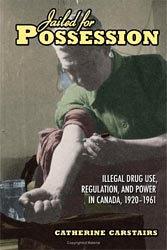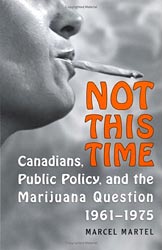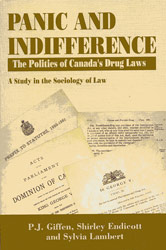
| Essential information for an informed debate about cannabis policy. |
Jailed for Possession:
by Catherine Carstairs As rates of illegal drug use increase, the debates over drug policy heat up. While some believe penalties should be harsher, others advocate complete decriminalisation. Certainly, debate over the 'war on drugs' is not new. In the early 1920s, as the drive for Chinese Exclusion gathered steam, Canadians blamed the Chinese for the growing use of opium and other drugs, and parliamentarians passed extremely harsh drug laws to counter this use. These laws remained in place until the 1960s. In Jailed for Possession, Catherine Carstairs examines the impact of these drug laws on users' health, work lives, and relationships. In the middle of the century, drug users regularly went to jail for up to two years for possession of even the smallest amount of opium, morphine, heroin, or cocaine, often spending more time incarcerated than on the street. As enforcement increased and drugs became harder to obtain, drug use became an increasingly central preoccupation, making it almost impossible for users to hold down steady jobs, support families, or maintain solid relationships. Jailed for Possession is the first social history of drug use in Canada and provides a careful examination of drug users and their regulators including doctors, social workers, and police officers. Catherine Carstairs is an assistant professor in the Department of History at the University of Guelph.
|
|||||||||||||||||||||||||
Not This Time:
Drugs are part of every society, consumed for ritual or religious purposes, for pleasure, to enhance athletic performance, or as a means to relieve pain. Throughout the twentieth century, however, an arbitrary and shifting distinction was made between legal drugs that were prescribed and administered by the medical profession, and illegal drugs that were subject to state control and suppression. Illegal in Canada since 1923, marijuana is the most controversial of illegal drugs. Because it lacks the same addictive and harmful qualities of other illegal substances, such as heroin and cocaine, marijuana's negative social impact is questionable. In the 1960s interest groups - including university student associations, certain physicians, and others -, began demanding changes to the Narcotics Control Act, which governed the legal status of drugs, to decriminalize or legalize the possession of marijuana. In Not This Time, Marcel Martel explores recreational use of marijuana in the 1960s and its emergence as a topic of social debate. He demonstrates how the media, interest groups, state institutions, bureaucrats and politicians influenced the development and implementation of public policy on drugs. Martel illustrates how two loose coalitions both made up of interest groups, addiction research organizations and bureaucrats - one supporting the existing drug legislation, and the other favoring liberalization of the Narcotics Control Act - dominated the debate over the legalization of marijuana, and how those favoring liberalized drug laws, while influential, had difficulty presenting a unified front and problems justifying their cause while the health benefits of marijuana use were still in question. Exploring both sides of the debate, Martel presents the invigorating history of a question that continues to reverberate in the minds of Canadians. Marcel Martel is an associate professor in the Department of History and holder of the Avie Bennett Historica Chair in Canadian History at York University.
|
|||||||||||||||||||||||||
Lies, Damned Lies, and Drug War Statistics: A Critical Analysis of Claims Made by the U.S. Office of National Drug Control Policy
This book critically analyzes claims made by the Office of National Drug Control Policy (ONDCP), the White House agency of accountability in the nation's drug war. Specifically, the book examines six editions of the annual National Drug Control Strategy between 2000 and 2005 to determine if ONDCP accurately and honestly presents information or intentionally distorts evidence to justify continuing the war on drugs. Matthew B. Robinson and Renee G. Scherlen uncover the many ways in which ONDCP manipulates statistics and visually presents that information to the public. Their analysis demonstrates a drug war that consistently fails to reduce drug use, drug fatalities or illnesses associated with drug use; fails to provide treatment for drug dependent users; and drives up the prices of drugs. They conclude with policy recommendations for reforming ONDCP's use of statistics, as well as how the nation fights the war on drugs.
|
|||||||||||||||||||||||||
Panic and Indifference: The Politics of Canada's Drug Laws
[Quote - pages 66-68] According to his own account, when he learned about the gambling and opium trade being carried on in Vancouver's Chinatown, he took the following actions: I took it up with the Chief of Police, but he just brushed me off. Then I went down into Chinatown itself, and visited the gambling joints and also saw personally the Chinese preparing raw opium for the market. When the Chief of Police refused to take any action, I used to publish in the Vancouver News Advertiser exactly what I had seen the night before. This I did for several weeks. It created quite a sensation in Vancouver, and as a result the civic authorities discharged the Chief and appointed Mr. Chamberlain. This man, when he became Chief of Police, did an excellent job in clearing up Chinatown (29). He described his role in bringing about the first opium Act as follows: (In 1908) I was responsible for the matter being brought to the attention of the then government. I remember taking some very prominent eastern gentlemen around Pacific Coast cities and showing them the effects and use of these drugs. They returned to Ottawa and put it up to Sir Wilfred Laurier, and the result was the Bill that was introduced (13d,p.2899).[snip] The motives of H. H. Stevens and of the city councils are open to question. They appear in this instance to have been concerned about moral reform and civic order but all were associated with anti-Chinese policies in other contexts. Stevens came to be recognized as the "the city's leading anti-Oriental spokesman" (30, p.91), in Parliament as at local rallies. Civic politicians, too, had an anti-Chinese rhetoric as part of their election kit and, once elected, usually supported the use of municipal ordinances and licensing powers for discriminatory purposes.[snip] The League's (Vancouver Anti-Opium League) representations to King(Mackenzie) included an urgent telegram at the time when the Bill was being sent to the Senate and the opium manufacturers were lobbying for a moratorium to protect their financial interests. INFORM GOVERNMENT NOT TO LET MANUFACTURERS DELAY LEGISTAION. CHINESE AT LARGE FAVOUR IMMEDIATE SUPPRESSION(2d). [Quote - page 203] Interested sections of the public became very vocal and active during the same period in in demanding more severe penalties. The cry for heavier punishment was the result of a drug scare created almost entirely by alarmist stories in the mass media. The stories, of which Emily Murphy's articles in _Maclean's_ were a prime example, reinforced pre-existing hostility to Orientals and augmented the horrifying spectre of the "dope fiend." The negative racial stereotypes and alarming drug mythology, spread by people who claimed to have first-hand knowledge, were accepted uncritically. The immediate result of these fears and hostility was the emergence of a British Columbia drug lobby in 1921, with the straightforward goals of compulsory imprisonment and whipping for all traffickers and, where possible, deportation. Public fears about narcotic drugs were particularly intense in British Columbia, the province with the largest concentration of Chinese immigrants. Accordingly, the greatest pressure on legislators for severe penalties originated in that province. Much of the demand for greater punitiveness was linked to animus against the Chinese and a desire to get rid of them, seen most clearly in the proposal for deportation. |
|||||||||||||||||||||||||
|
|||||||||||||||||||||||||




